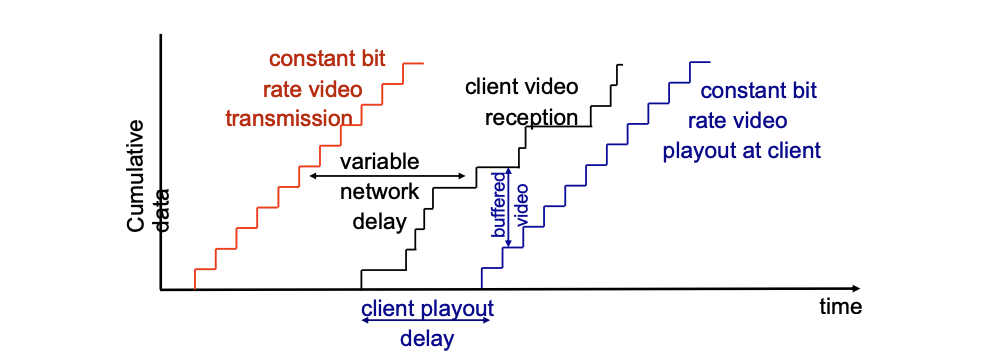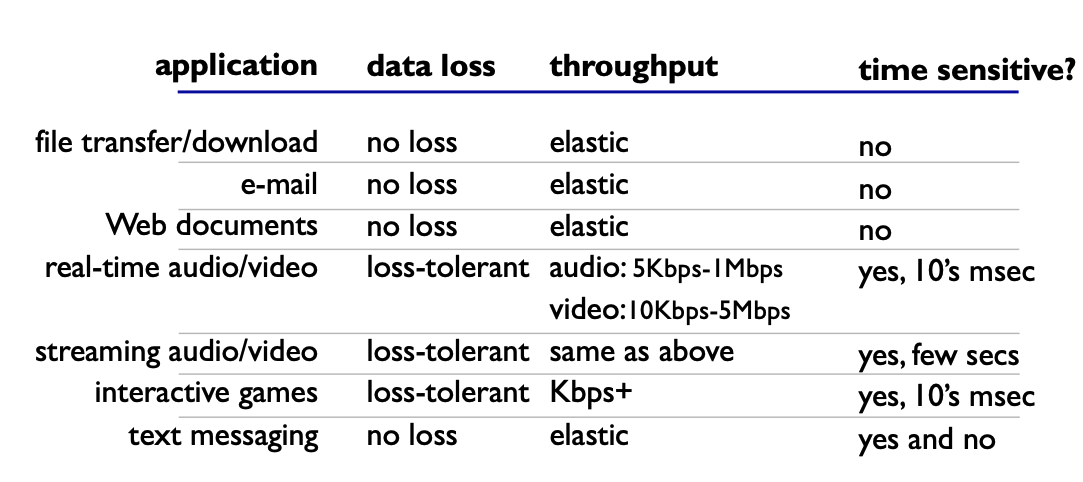Application Layer
Principles of Network Applications
Client-server paradigm
- Server
- Permanent IP
- always-on host, often in data center
- Clients
- contract and communicate with server
- can be intermittently connected
- IP address can be dynamic
- Don't communicate directly with each other
- HTTP, FTP
Peer to peer architecture
- no always-on server
- arbitrary end systems directly communicate
- request and provide services mutually
- self scalability - new peers bring new service capacity and service demands
- peers are intermittently connected and change IP address
- e.g. P2P file sharing, blockchain
process communication
- within the host, process reply inter-process communication (defined by OS)
- for different host, communicate by exchanging messages
socket
- communication channel, can push and pop from it
- can be TCP and UDP
- identifiers
- 32-bit unique IP address, and port number
application protocol defines:
- Message type exchanged
- message syntax
- message semantics (meaning of information in fields)
- rules for process to send and receive messages
considerations when choosing app
- Data integrity
- tolerance to loss
- Timing
- delay
- Throughput
- Streaming has minimal throughput requirements
- Security
TLS - transport layer security
- provide encrypted TCP connections
Web and HTTP
- link object including HTML file, image, javascript
- Uniform Resource Locator (URL)
HTTP
- Hyper text transfer protocol
- Web's application layer protocol
- Stateless - maintain no information about past client requests
- HTTP request messages
HTTP 1.x header are all text
- Not most efficient
HTTP/2
- Transmission order for the requests object based on client-specific priority (not FCFS)
- Divide object into frames, and schedule frames to mitigate HOL blocking
- Break objects into smaller chunks, and interleaving these chunks for sending
- Can push unrequested objects to client
HTTP/3
- uses UDP using QUIC
HTTPS
- Connection encrypted by Transport Layer Security (TLS)
Cookies
- Maintain some state between transactions
- Four Components:
- Cookie header line of HTTP response message
- Cookie header line in next HTTP request message
- Cookie file kept on user's host, managed by user's browser
- Back-end database at website
Performance of HTTP
- Page Load Time (PLT) - from click to show of the page
- Can improve HTTP, cache, and horizontal scale the resources
- RTT - time for small packet to travel from client to server and back
- Non-persistent HTTP response time = 2 RTT + file transmission time
How to improve performance
- Concurrent requests and responses
- Not necessarily in order
- Overloading the server
- Reduce content size for transfer
- Persistent connection and pipelining
- Avoid repeat transfers of the same content
- Move content closer to the client
- Replication
- Replicate website across machines
- Spread the load across servers
- Expensive
- Replicate website across machines
- CDNs
- Cacheing and replication as a service
- Large scale distributed storage infrastructure
- Pull or push replications
- Dynamic content can also be handled
- Cacheing and replication as a service
- Replication
Persistent HTTP
- Leave TCP connection open after sending response
- Pipelining
- Client send req as soon as it encounters a referenced object
- Rather then only sending req after receiving previous resp
Cacheing
- Not for many unique requests (since dynamic content are increasing like video content)
- Web caches/proxy servers
- User make initial request to proxy server
- If cache miss, make request to original server
- COMP3311 cache calculations
- Conditional GET
- Don't send object if cache has up-to-date cached version
- In req, contain modification date
Electronic Mail
- User agents (mail reader)
- Mail servers
- mailbox for all incoming messages
- message queue of outgoing mails
- SMTP
- between mail servers to send email messages
- Uses TCP under the hood
- Three way handshake
- Message must be ASCII
- Command/response
- command: ASCII test
- response: status code and phrase
- Push protocol, which is different that TCP
- Persistent connection
- Multiple message sent in multipart, rather than each object encapsulated in its own resp message
DNS
- Distributed database implemented in hierarchy of many name servers
Functions:
- Map between IP address and host names
- Application layer protocol
- host aliasing
- Canonical name (CNAME), the true main host name
- Alias names, alternative names that maps to CNAME
- mail server aliasing
- route emails to correct mail server by Mail Exchange (MX) records
- load distribution
- load balancing to improve performance
- replicate web servers
Characteristics:
- Uniqueness of names
- Scalable
- storage
- handle large scale requests
- Distributed, autonomous administration
- Ability to update my own domain names
- Highly available
- Fast lookup
DNS Hierarchy
Hierarchical namespace
- From bottom to the top (unsw.edu.au)
H administered
- Root sever -> Top-level domain (TLD) -> Authoritative DNS servers
- Each server stores a small subset of the total DNS database
- Every server know root server
- root server knows about all TLD
- Root server
- If cannot resolve the name, it will reach root
- Managed by ICANN (Internet Corporation for Assigned Names and Numbers)
- Top-level domain (TLD)
- .com, .org, .au ...
- Authoritative DNS servers
- belongs to organisations
- Local DNS name servers
- Cache
- Timeout after reached TTL
- If host changes IP, cache might be outdated
- negative cache (things that don't work, prevent make the req again)
- Not strictly belong to the hierarchy
- Each ISP such as residence, company has one
- Cache
- Types of query
- Iterative, where the local DNS server make consecutive req starting from root, to its child... util find the result
- Recursive, where local DNS send req to root, and root would send recursive req to its chile
- Heavy load at upper levels
- DNS records
H of servers (distributed)
Reliability
- DNS servers are replicated, and load-balanced between replicas
- UDP is usually used
DNS security
- DDoS attacks
- man-in-middle
- intercept DNS queries
- DNS poisoning
P2P Applications
- Self scalability - new peer bring new service capacity
- Examples: BitTorrent, Crypto
Video Streaming and Content Distribution Networks (CDNs)
- Videos are essentially array of pixels
Challenges
- Network delay are variable (need client side buffer)
- Packets might be lost

DASH
- Dynamic, Adaptive Streaming over HTTP
- Streaming video = encoding + DASH + playout buffering
Server
- Divide video file into multiple chunks
- Each chunk stored, and encoded at different rates
- Provide URL for different chunks
Client
- Periodically measure server-client bandwidth
- Request one chunk at a time
- Choose max coding rate sustainable given the current bandwidth
- can choose different coding rate at different points in time
- client determines:
- When to request chunk - avoid starvation
- What encoding - higher quality if bandwidth is sufficient
- Where to request - from URL server that is closer or has high available bandwidth
CDNs
- Stores copies of content at CDN nodes
- Subscriber request content from CDN
- Usually combination of push and pull CDN
Over-the-top (OTT) - delivery of content over internet without requiring user to subscribe to traditional cable, satellite...
The role of the CDN provider’s authoritative DNS name server in a content distribution network, simply described, is:
- to map the query for each CDN object to the CDN server closest to the requestor (browser)
Socket Programming with UDP and TCP
UDP
- No connection or handshake
- Sender attach destination IP address and port # to each packets
- transmitted data may be lost or receive out-of-order (unreliable transfer)
TCP
- connection must be established
- provides reliable, in-order byte-stream transfer between client and server
- 1 to 1 mapping between client and server side sockets and ports
- ! 200
- When server socket is busy, incoming connection request are stored in a queue (if queue is full, new req would be dropped)
Concurrency
- Parent process creates a welcome socket
- Once received a connection request, new process would be assign to service the connection socket, and the parent process would be free up to function as the welcome socket.
